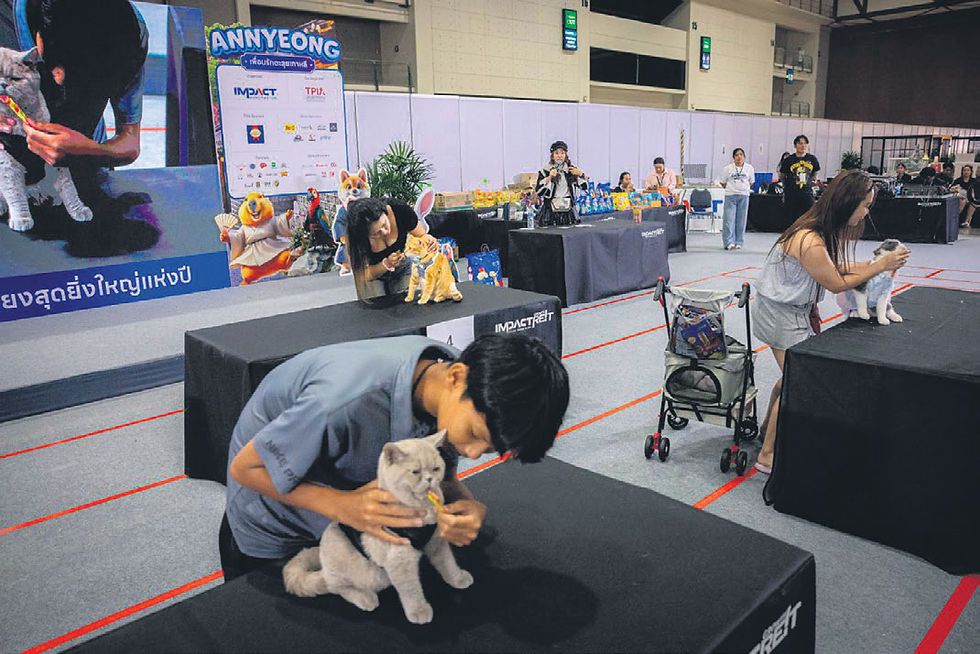A rescue dog went blind. Now she’s helping other pups avoid her fate.
- The San Juan Daily Star

- Aug 27, 2024
- 4 min read

By Seth Kugel
All dogs, it must be said, are born great. Most achieve greatness in their own waggy ways. But some — like Shola, a 9-year-old English Shepherd — have greatness thrust upon them.
In her first act as a canine hero, Shola fought through mountainous terrain and dangerous weather to search for missing people in England’s central Peak District and other rural areas.
Her second act began in 2019, when, at the age of 4, she was diagnosed with an inherited, incurable form of blindness. Her owners approached an eye specialist to understand more about her condition and, eventually, a sample of her DNA taken from a cheek swab landed at the Canine Genetics Center at the University of Cambridge.
Using Shola’s DNA and samples collected from other English Shepherds, researchers pinpointed the mutation that had caused her blindness and developed a test to identify it in other dogs. Their findings were shared in a paper published last month in Genes, a peer-reviewed journal.
While the discovery came too late to save Shola’s sight, her DNA has already helped protect future generations of her breed. “We’ll never have any more blind puppies,” said Jackie Graves, 62, who bred Shola and whose current litter is from two dogs who tested negative for the mutation.
The discovery is part of an expanding field of canine genetic research, which helps breeders identify potential mutations. Curious owners can also untangle the lineage of their mutt using commercially available pet DNA tests.
Shola has progressive retinal atrophy, a group of diseases that affect more than 100 dog breeds and involve the gradual deterioration of light-sensitive cells at the back of the eye. (There are also tests for different mutations that affect other breeds.) It turned Shola’s eyes milky and sightless.
The mutation is recessive and causes a “late onset” form of the condition: It often presents after dogs have had puppies. (Shola retired from search-and-rescue operations at age 5, after she had had a litter.)
Once dogs develop the disease, “there’s nothing you can do,” said Katherine Stanbury, a researcher at Cambridge’s department of veterinary medicine and lead author of the study. Because so many dog breeds are highly inbred, many individual dogs are related, raising the possibility that they could be affected by a recessive disease.
The walls of Stanbury’s office are decorated with photos of dogs — including Shola — whose DNA she is combing through to find the causes of blindness. Stanbury has spent years studying inherited eye diseases as part of a team dedicated to learning more about canine genetics.
The new test, which can be bought for 48 pounds ($62), involves a cheek swab sent to the lab in Cambridge for testing. It allows breeders of English Shepherds to identify dogs that carry the mutation, Stanbury said. “They can make informed decisions with their breeding and, eventually, breed this variant out,” she said.
English Shepherds, which are far more common in the United States and closely related to Border collies, are known to be agile, loyal and easy to train. Initially, they were bred to help farmers with tracking and herding livestock, as well as hunting pests and protecting the family.
Shola was raised by John Coombs, 72, who joined England’s mountain rescue organization as a volunteer around age 30 and has rescued several people with his dogs.
From the age of 2, Shola accompanied him on search operations across Britain. “The bond that you have is unique,” he said.
Handlers and dogs go through years of hard training together. Sometimes, they endure tragedy together: Not everyone is found alive.
Shola would set out with a simple command: “Seek and find.” She would dart off, zigzagging to chase a scent. If she located a person or a piece of clothing, she would lead Coombs to the find.
Shola stopped working after her eyesight started to go. First, the Coombs family noticed that she seemed to prefer bright yellow balls. Then, on a nighttime search, she fell into a ditch.
“It was fairly obvious that there was something wrong,” Coombs recalled.
Today, Shola’s nose and ears have become her guides.
She happily runs for a ball, if she hears it bounce. (She did plow straight into a New York Times journalist, but quickly recovered.)
She is also an especially enthusiastic sniffer. On walks through Newton, a village in Derbyshire, Shola keeps her nose cocked to her person’s footsteps. She follows directly behind, stepping where the person steps — almost as if following the human through snow. Her owners use the command “Careful” to warn of obstacles.
“She will smell treats at 40 paces,” Lindsey Coombs, who has taken over from her father as Shola’s chief person, said, laughing.
On a summer evening in late July, Shola danced around John Coombs in a field. Her daughter Dotty, who is working as a search-and-rescue dog, pranced by her side.
“Seek and find!” he told Dotty after hiding a handbag. Dotty zigzagged to track its scent to a bush.
When Dotty found it, Shola barked, too.






Ce qui m'a le plus impressionné avec la construction métallique, c'est la combinaison parfaite de résistance et de design. Nous avons pu concrétiser un projet architectural audacieux grâce à cette technologie, sans jamais compromettre la solidité. De plus, la rapidité de montage nous a permis de respecter nos délais serrés. Si vous cherchez une solution fiable, durable et esthétique pour votre prochaine construction, la construction métallique est la voie à suivre!